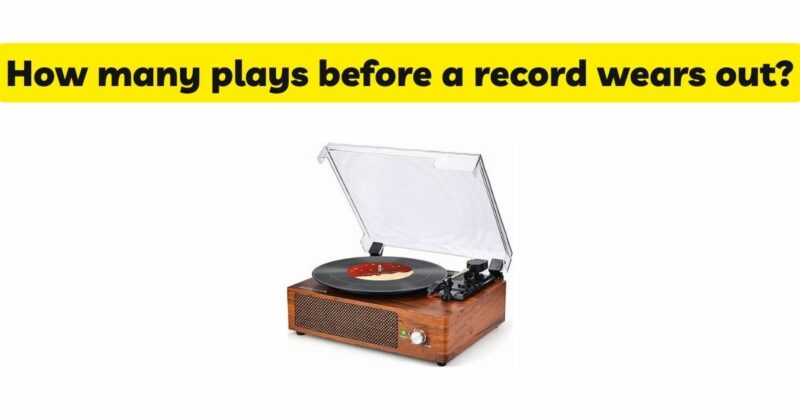Vinyl records have experienced a resurgence in popularity in recent years, captivating music enthusiasts with their warm sound and nostalgic appeal. However, one common concern among vinyl lovers is the lifespan of their records. How many times can a record be played before it starts to wear out? In this article, we explore the factors that affect the durability of vinyl records and provide insights into their average lifespan.
Understanding Vinyl Records
Vinyl records are made from polyvinyl chloride (PVC) material and consist of microscopic grooves that store audio information. When a stylus (needle) makes contact with these grooves, it reproduces the recorded sound. To protect the grooves and ensure optimal playback, vinyl records are typically coated with a thin layer of plastic called a “record pressing.” Despite this protection, records can wear out over time due to various factors.
Factors Affecting Record Lifespan
The lifespan of a vinyl record depends on several factors. Understanding these factors can help record collectors and enthusiasts take appropriate measures to preserve their vinyl collection:
- Record Quality: The quality of the record itself plays a significant role in its longevity. High-quality records manufactured with attention to detail, using good materials and production techniques, tend to last longer. Records pressed with thicker vinyl are generally more durable than those with thinner vinyl.
- Playback Equipment: The type and quality of playback equipment used can impact a record’s lifespan. High-quality turntables with properly aligned and calibrated tonearms, accurate tracking force, and clean, well-maintained needles reduce the risk of excessive wear on the grooves. Conversely, using subpar or misaligned equipment can contribute to premature record deterioration.
- Needle Condition: The condition of the needle or stylus that comes into contact with the record’s grooves is crucial. A worn or damaged needle can cause increased friction and exert excessive pressure on the grooves, leading to accelerated wear. Regular needle maintenance, such as cleaning and replacement when necessary, is essential for preserving records.
- Playback Technique: The way records are played also affects their lifespan. Mishandling records, dropping them, or forcefully cueing the stylus onto the surface can cause scratches, skips, or even groove damage. Gentle handling and careful needle placement can help extend the record’s lifespan.
- Environmental Factors: Environmental conditions, such as temperature, humidity, and exposure to sunlight, can impact the longevity of vinyl records. Extreme temperature fluctuations, high humidity levels, and prolonged exposure to direct sunlight can warp records or degrade the vinyl material over time. Storing records in a controlled environment away from direct sunlight and fluctuations in temperature and humidity can help preserve their lifespan.
- Cleaning and Maintenance: Regular cleaning and proper maintenance of records are vital for their longevity. Dust, dirt, and debris can accumulate in the grooves and cause increased friction, leading to premature wear. Using appropriate cleaning methods and tools, such as carbon fiber brushes and record cleaning machines, can help keep records clean and reduce the risk of damage during playback.
Average Lifespan of Vinyl Records
The lifespan of a vinyl record is challenging to determine with absolute precision. However, on average, a well-maintained record can be played approximately 1000 times without significant degradation in sound quality. This estimate assumes proper handling, cleaning, and maintenance, as well as the use of high-quality playback equipment. It is worth noting that records played on higher-quality turntables with accurate tracking force and well-maintained needles tend to last longer.
It is important to remember that the number of plays is not the only factor to consider when assessing a record’s condition. The cumulative effect of other factors, such as environmental conditions and playback technique, can also impact the record’s lifespan.
Extending the Lifespan of Vinyl Records
While the lifespan of a vinyl record is influenced by various factors, there are several steps you can take to maximize its longevity:
- Proper Handling: Handle records with care, always grasping them by the edges to avoid touching the playing surface. Avoid placing records on surfaces where they can get scratched or damaged.
- Clean Records Regularly: Regularly clean your records to remove dust, dirt, and debris that can cause increased friction and premature wear. Use appropriate record cleaning tools and methods to minimize the risk of damage during the cleaning process.
- Maintain Playback Equipment: Keep your turntable and playback equipment in optimal condition. Regularly clean and align the stylus, ensure accurate tracking force, and periodically check for any misalignments or issues that may affect playback quality.
- Store Records Properly: Store records upright in a cool, dry, and stable environment away from direct sunlight, heat sources, and excessive humidity. Consider using anti-static inner sleeves and outer protective sleeves to provide an extra layer of protection against dust and scratches.
- Rotate Your Collection: Avoid excessive repeated plays of the same records. By rotating your collection and giving records a break between plays, you can distribute the wear evenly across your entire collection.
- Replace Worn Needles: Regularly inspect and replace worn or damaged needles. A damaged or worn-out needle can cause irreversible damage to your records.
Conclusion
Vinyl records continue to captivate music enthusiasts with their unique sound and tactile experience. While the lifespan of a vinyl record depends on various factors, taking proper care, handling records gently, maintaining playback equipment, and providing a suitable storage environment can significantly extend their longevity. By implementing the tips and strategies outlined in this article, you can enjoy your vinyl collection for years to come, ensuring that your favorite albums continue to provide you with countless hours of musical enjoyment without significant degradation in sound quality.


